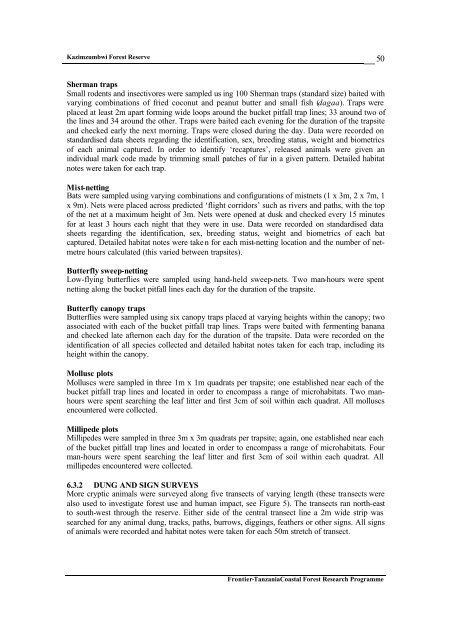Frontier Tanzania Environmental Research REPORT 110 ...
Frontier Tanzania Environmental Research REPORT 110 ...
Frontier Tanzania Environmental Research REPORT 110 ...
Create successful ePaper yourself
Turn your PDF publications into a flip-book with our unique Google optimized e-Paper software.
Kazimzumbwi Forest Reserve<br />
50<br />
Sherman traps<br />
Small rodents and insectivores were sampled us ing 100 Sherman traps (standard size) baited with<br />
varying combinations of fried coconut and peanut butter and small fish (dagaa). Traps were<br />
placed at least 2m apart forming wide loops around the bucket pitfall trap lines; 33 around two of<br />
the lines and 34 around the other. Traps were baited each evening for the duration of the trapsite<br />
and checked early the next morning. Traps were closed during the day. Data were recorded on<br />
standardised data sheets regarding the identification, sex, breeding status, weight and biometrics<br />
of each animal captured. In order to identify ‘recaptures’, released animals were given an<br />
individual mark code made by trimming small patches of fur in a given pattern. Detailed habitat<br />
notes were taken for each trap.<br />
Mist-netting<br />
Bats were sampled using varying combinations and configurations of mistnets (1 x 3m, 2 x 7m, 1<br />
x 9m). Nets were placed across predicted ‘flight corridors’ such as rivers and paths, with the top<br />
of the net at a maximum height of 3m. Nets were opened at dusk and checked every 15 minutes<br />
for at least 3 hours each night that they were in use. Data were recorded on standardised data<br />
sheets regarding the identification, sex, breeding status, weight and biometrics of each bat<br />
captured. Detailed habitat notes were take n for each mist-netting location and the number of netmetre<br />
hours calculated (this varied between trapsites).<br />
Butterfly sweep-netting<br />
Low-flying butterflies were sampled using hand-held sweep-nets. Two man-hours were spent<br />
netting along the bucket pitfall lines each day for the duration of the trapsite.<br />
Butterfly canopy traps<br />
Butterflies were sampled using six canopy traps placed at varying heights within the canopy; two<br />
associated with each of the bucket pitfall trap lines. Traps were baited with fermenting banana<br />
and checked late afternon each day for the duration of the trapsite. Data were recorded on the<br />
identification of all species collected and detailed habitat notes taken for each trap, including its<br />
height within the canopy.<br />
Mollusc plots<br />
Molluscs were sampled in three 1m x 1m quadrats per trapsite; one established near each of the<br />
bucket pitfall trap lines and located in order to encompass a range of microhabitats. Two manhours<br />
were spent searching the leaf litter and first 3cm of soil within each quadrat. All molluscs<br />
encountered were collected.<br />
Millipede plots<br />
Millipedes were sampled in three 3m x 3m quadrats per trapsite; again, one established near each<br />
of the bucket pitfall trap lines and located in order to encompass a range of microhabitats. Four<br />
man-hours were spent searching the leaf litter and first 3cm of soil within each quadrat. All<br />
millipedes encountered were collected.<br />
6.3.2 DUNG AND SIGN SURVEYS<br />
More cryptic animals were surveyed along five transects of varying length (these transects were<br />
also used to investigate forest use and human impact, see Figure 5). The transects ran north-east<br />
to south-west through the reserve. Either side of the central transect line a 2m wide strip was<br />
searched for any animal dung, tracks, paths, burrows, diggings, feathers or other signs. All signs<br />
of animals were recorded and habitat notes were taken for each 50m stretch of transect.<br />
<strong>Frontier</strong>-<strong>Tanzania</strong>Coastal Forest <strong>Research</strong> Programme

















